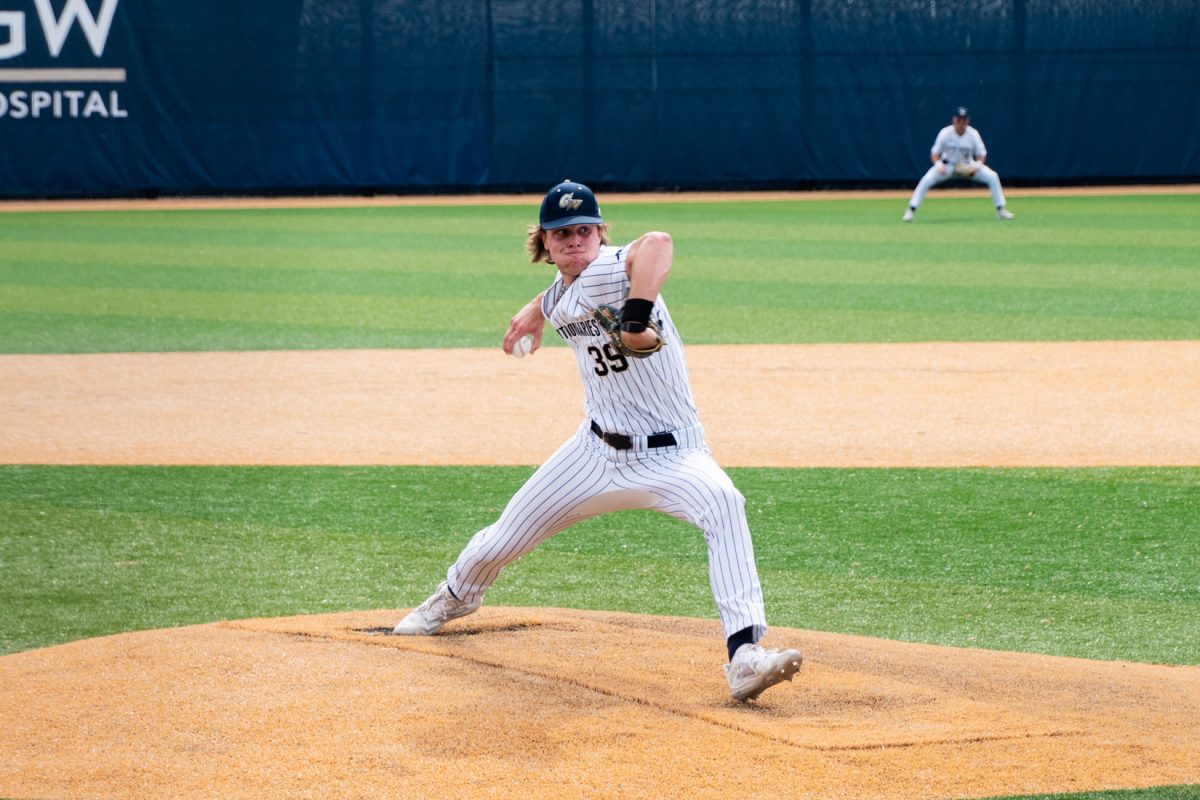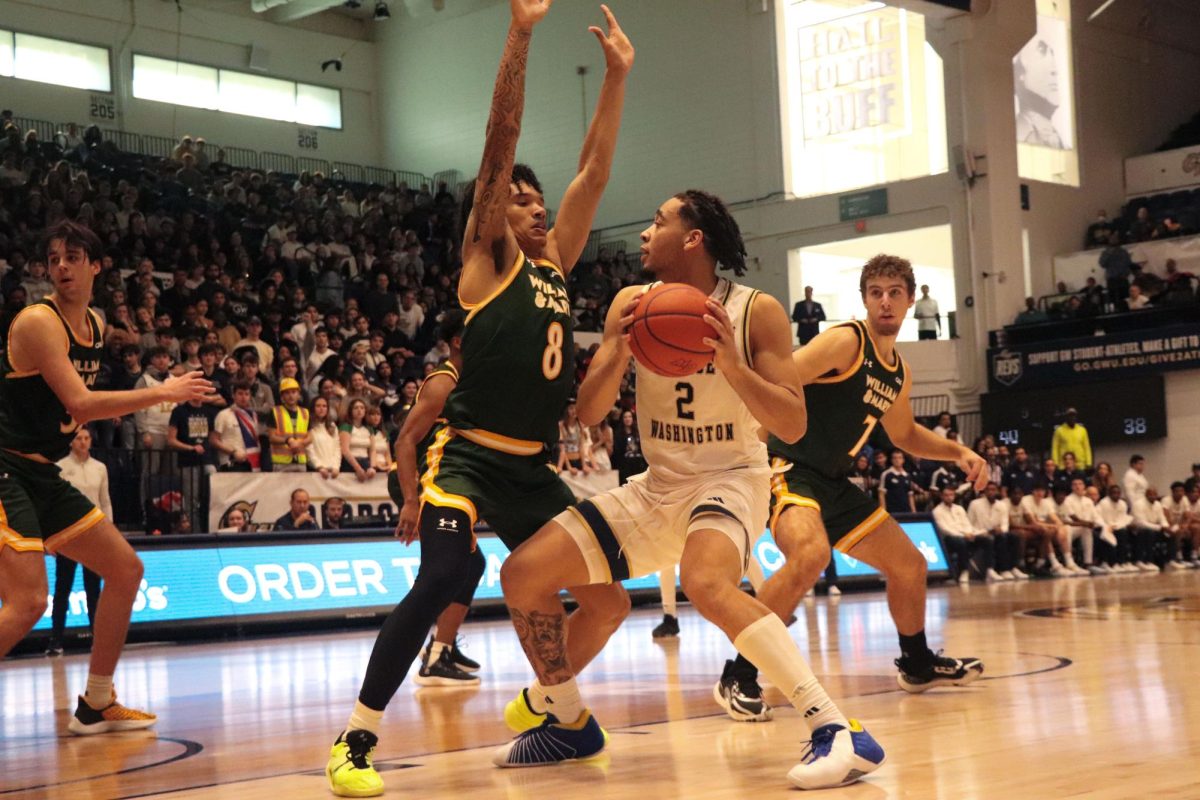Third in a series of articles
Well, before Thanksgiving, we were telling our friend from the University of North Carolina a little about the GW men’s basketball program. Before our boys took their own little trip to face a UNC satellite school Sunday night, we had reviewed the history of the team from 1906 to 1966.
Have you been impressed so far, Tar Heel Fan? (Well, I’m a little worried for you guys. According to you, your best player and best coach left campus more than 30 years ago.) Okay, good point. That’s probably what fans of the Colonials were thinking when Coach Bill Reinhart left in 1966.
The next 25 years would do little to encourage them. In this installment we’ll look at those dark ages.
The 1960s swiftly brought eight straight losing seasons. If losing was new around here, it had company. There were lots of new experiences to go around – it was that kind of decade. The Student Assembly abolished itself, tear gas was used on campus and GW football decided its chances of winning would be about the same if the team didn’t even play.
In 1966, an all-black basketball team from Texas Western (now the University of Texas at El Paso) beat the University of Kentucky for the NCAA Championship. Schools across the country, including GW, wasted no time breaking their own color barriers, and in 1967 an African American, Garland Pinkston, put on a Colonials’ uniform for the first time.
In 1970, GW withdrew from the Southern Conference, citing a lack of quality opponents. The Southern Conference survives today but only as a shadow of the league that UNC, Duke University and GW once called their own.
In the tradition of the Holups (their little brother, Ray, played a season with the freshman team in the 1960s), the Tallent brothers took over at GW. In 1968-’69, Bob Tallent set a GW single-season record by averaging 28.9 points per game. Until 1981, a Tallent (either Bob, Mike or Pat) would call Foggy Bottom home.
In 1970, Carl Slone took over the program. Dr. Arthur Kirsch, a GW graduate (1955) and professor (since 1960), has been a GW fan since junior high, and has missed, at most, three games ever held at the Smith Center. His brother even played for the football team. He’s such a super-fan, The Washington Post profiled him in the 1980s. He remembers Carl Slone well.
“Slone was a superb coach,” Kirsch said. “He was excellent. Unfortunately, his alma mater, Richmond, hired him away from us.”
In 1974, GW joined the Eastern Collegiate Basketball Conference, and Bob Tallent became coach. He won immediately with Slone’s players. The Smith Center (named for deep-pocketed donor Charles E. Smith) opened in time for the 1975-’76 season, and Tallent’s team promptly turned in a 20-7 season. GW’s first season with an on-campus playing facility was successful, but otherwise, the Tallent years were unremarkable. But the team had no postseason success. And in the conference tournaments, GW couldn’t buy a win.
The 1960s had brought total futility, and the 1970s were not much better. GW’s rich tradition was being buried in mediocrity. Upon the completion of the Smith Center, the “Tin Tabernacle,” GW’s greatest symbol of the Reinhart years, was torn down, leaving a single brick that now is housed in a Smith Center trophy case. Center court now hangs in the upstairs southwest corner of the gym.
In 1976, GW became a founding member of the Eastern Collegiate Basketball League, and in 1977, the ECBL became the Eastern Eight. In 1978, GW announced that buying basketball tickets was “capital idea.”
As the 1980s dawned, Tallent left. But Kirsch thinks Tallent deserves some credit.
“Tallent would have been a good coach, but he just didn’t have the support of the administration,” Kirsch said.
GW was struggling, but managed to end a seven-game slide in 1981 with a win over Massachusetts. UMass was an easy win, the 1981 Cherry Tree reported, making the foreshadowing statement that Massachusetts was “the Eastern Eight’s version of the Toronto Blue Jays.”
In 1982, GW played its last game against Georgetown University, ending the series with GW’s most frequent opponent. The 96th and last meeting was a loss. Georgetown would win a national championship two years later. GW boosters began to lament that American University and the University of the District of Columbia were pulling in more fans than the Colonials. The Eastern Eight became the Atlantic 10.
Between 1981 and 1985, center Mike Brown lent his considerable talents to the team, becoming GW’s second all-time leading scorer (1,916 points – behind Joe Holup, of course). Even with Brown, the Colonials could only muster one winning season. The 1985 Cherry Tree wondered if “GW will ever be a name on the national basketball map.”
In 1984-’85, the NCAA Tournament expanded to 64 teams and byes were eliminated. In 1985, the 45-second shot clock was introduced, and Mike Brown was drafted by the Chicago Bulls in the third round. John Kuester, coach at Boston University, took over GW’s program.
In 1986, the three-point line was introduced to the college game, and Kuester promptly turned in three losing seasons. GW introduced its new athletic logo, which would not be put out of its misery until this year. Even uglier than that logo was the masterpiece Kuester turned in for the 1988-’89 season. That year, which will live forever in infamy, GW went a horrendous 1-27, with the lone win coming against UMass. Sports Illustrated wrote of GW in 1989, “We could tell you that the Colonials are ready to challenge the top tier. But in deference to the school’s namesake, who couldn’t tell a lie, we won’t.”
Super-fan Arthur Kirsch went to every home game that year.
“The hysterics when we beat UMass,” Kirsch remembers with a laugh. “We cut down the nets, ran on the court.”
Stephen Joel Trachtenberg, who had just became president of the university in 1988, remembers that season.
“I was a little embarrassed by it,” said Trachtenberg, GW’s 20th president. “If you’re going to be in Division I, it’s child abuse to send teams out that are overmatched. If the athletic department and the administration don’t have enough heart to field a competitive team, they should just play in Division III.”
On Monday, look for the final installment: The ’90s and the future.
Click here to read part one of the series.
Click here to read part two of the series.







